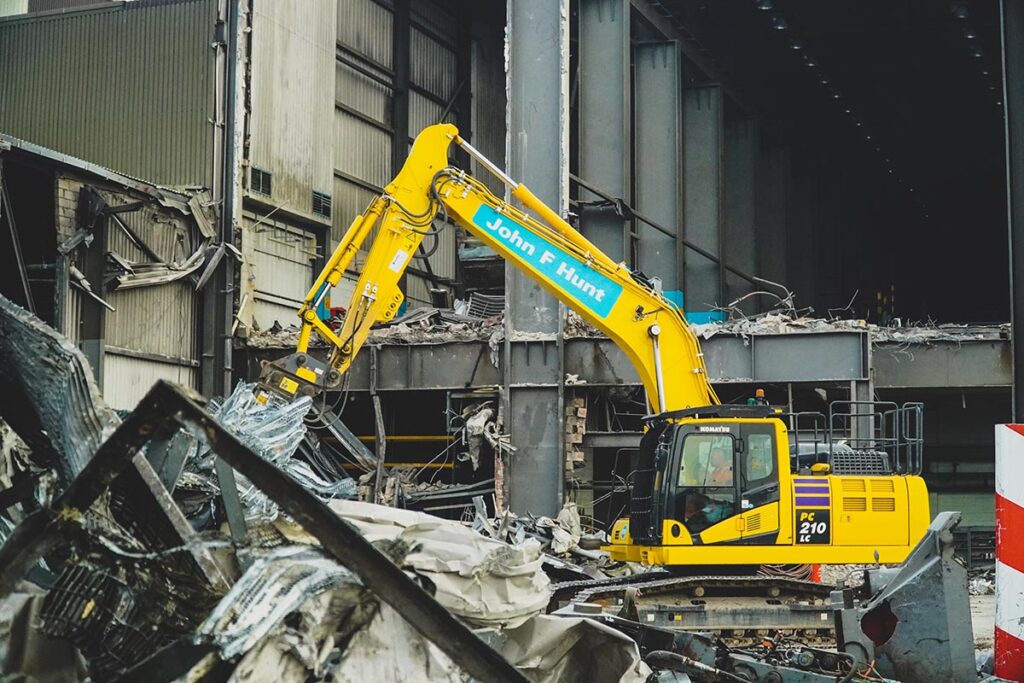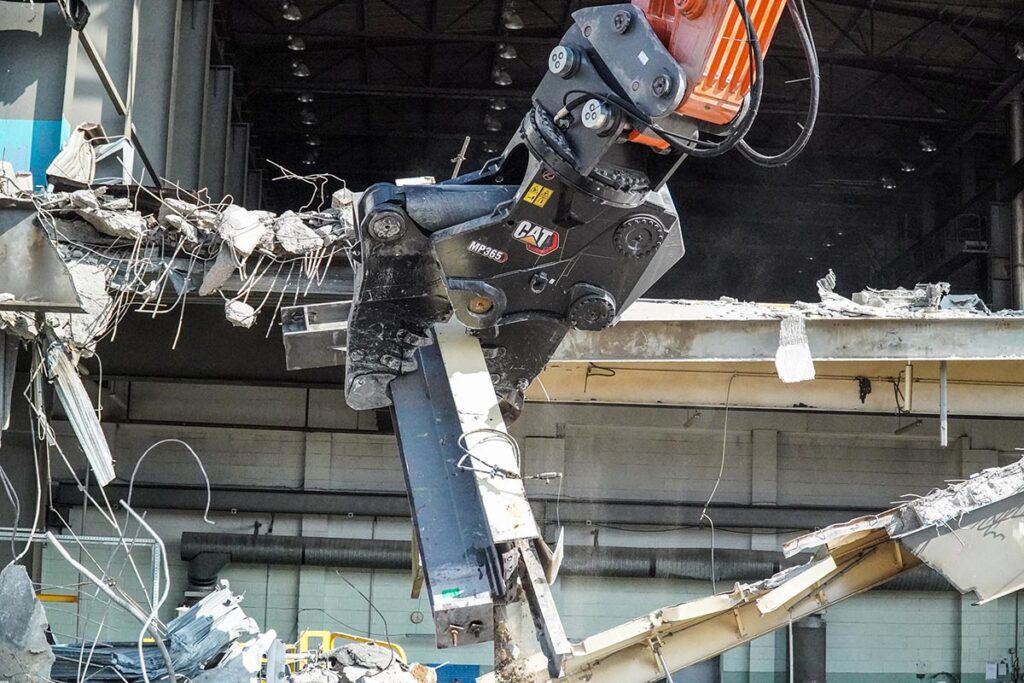Demolition is a complex process with significant environmental implications. It involves systematically tearing down industrial structures, often to make way for new construction or land repurposing. As industries increasingly recognise the importance of environmental sustainability, there is a growing emphasis on demolition activities that minimise ecological impact, maximise resource recovery, and support overall sustainability goals. This approach is known as sustainable industrial demolition.
The Environmental Impact of Traditional Demolition
Demolition activities, particularly in the industrial sector, often have a significant environmental footprint. They can generate significant solid waste, including metal, concrete, bricks, and potentially hazardous substances like asbestos. Without proper management, this waste can pose serious environmental risks, contaminating soil and groundwater and contributing to landfill use.
One key aspect of this is the creation of dust, which can act as a serious pollutant. This dust can contaminate natural spaces and communities, leading to health issues and ecological damage. Dust pollution is particularly problematic during demolition due to the sheer volume of material being disturbed and the wide variety of substances present in industrial buildings.

The Role of Buildings in Energy and Material Consumption
The construction and demolition sector is a significant consumer of resources and energy. Buildings, including their construction, operation, and demolition, account for 40% of the global energy consumption and resource use. This is due to the energy-intensive nature of construction materials and processes and the energy used in building operation and maintenance.
When a building is demolished, the embedded energy in its materials is wasted if not recovered and reused. This wastage contributes to the overall energy footprint of the demolition process, making it a key area of focus for sustainable practices.
Sustainability in Demolition
Sustainable demolition involves carefully deconstructing buildings to maximise the recovery of materials for reuse and recycling. This approach contrasts with traditional demolition methods, often resulting in significant waste. Sustainable demolition practices include:
Selective Demolition: Targeted removal of specific building components for reuse or recycling, preserving valuable materials that would otherwise be discarded.
Material Assessment: Before demolition, conduct assessments to identify materials that can be salvaged, reused, or recycled.
Deconstruction: Dismantling buildings piece by piece to preserve the integrity of materials, allowing for higher rates of reuse.
Opportunities for Material Reuse
Material reuse offers several environmental and economic benefits, including reducing the demand for new materials, conserving natural resources, and lowering the energy consumption associated with manufacturing new products. Opportunities for material reuse include:
Structural Components: Beams, columns, and other structural elements can be repurposed in new construction projects or as architectural features.
Bricks and Masonry: Bricks and other masonry materials can be cleaned and reused, offering new buildings aesthetic and historical value.
Doors and Windows: Doors, windows, and fixtures can often be reused, contributing to the character of renovations or new builds.
Recycling Demolished Materials
When reuse is not feasible, recycling demolished materials can still provide significant environmental benefits. Commonly recycled materials include:
Concrete: Crushed and reused as aggregate in new concrete or as a base material for roads and pathways.
Metals: Steel, aluminium, and other metals can be efficiently recycled with minimal loss of quality, reducing the need for virgin ore mining.
Wood: Wood can be chipped as biomass fuel, mulch, or engineered wood products.

Steps to Achieve Sustainable Demolition
Achieving sustainable demolition requires a paradigm shift from traditional demolition practices. It involves careful planning, thorough assessment of the building structure, and a commitment to minimise waste and recycle materials wherever possible.
In the planning stage, a detailed assessment can identify the materials present in the building and determine the best methods for their removal and disposal. This assessment can also identify hazardous materials, like asbestos, requiring special handling.
A waste management plan is a crucial part of sustainable demolition. It outlines how waste will be minimised, sorted, and disposed of, with a strong focus on reusing and recycling building materials. This can significantly reduce the amount of waste sent to landfills and contribute to resource conservation.
Sustainable demolition also involves using technology to minimise dust and other pollutants. Advanced machinery and techniques can reduce the amount of dust generated during demolition, while dust suppression measures can prevent it from spreading.
Efforts should also be made to mitigate the impact of demolition on local ecosystems. This could involve scheduling demolition activities to avoid breeding seasons for local wildlife and implementing measures to protect habitats from disturbance.
Benefits of Sustainable Demolition
Embracing sustainable demolition practices brings multiple benefits, ranging from environmental to economic and social.
On the environmental front, sustainable demolition reduces pollution and waste, contributing to cleaner air and healthier ecosystems. By minimising dust and managing waste effectively, it also reduces the risk of soil and groundwater contamination. Furthermore, by taking steps to protect local wildlife and their habitats, sustainable demolition can help to maintain biodiversity and ecosystem health.
The economic benefits of sustainable demolition primarily stem from efficient resource use. Advanced recycling techniques can recover valuable materials from demolished buildings, reducing the need for new materials and cutting costs. Furthermore, waste management measures can reduce disposal costs, further saving businesses.
On the social front, sustainable demolition can enhance community relations and improve public image. By taking steps to minimise dust and noise and by implementing measures to protect local ecosystems, businesses can demonstrate their commitment to their communities and the environment. This can foster goodwill and trust, contributing to a positive corporate reputation.

Case Study: Successful Sustainable Deconstruction
A perfect example of a successful sustainable demolition project is the deconstruction of the Park Avenue Hotel in Detroit. The 13-story structure was deconstructed rather than demolished, which allowed for the recovery and recycling of a significant portion of the building materials, thereby reducing waste and conserving resources.
The project team used advanced machinery and dust suppression measures to minimise dust and other pollutants. They also implemented a comprehensive waste management plan, including segregating recycling materials. As a result, they could divert a significant proportion of the demolition waste from the landfill.
The project achieved significant environmental, economic, and social benefits through careful planning and implementing sustainable practices. It is an excellent example of how sustainable industrial demolition can be achieved.
Conclusion
As industries worldwide strive to reduce their environmental impact and embrace sustainability, sustainable industrial demolition has a crucial role to play. Minimising pollution and waste, protecting local ecosystems, and efficiently using resources can significantly reduce demolition activities’ environmental footprint.
However, achieving sustainable demolition requires a shift from traditional practices. It requires careful planning, effective waste management measures, technology to minimise pollutants, and a commitment to protecting local ecosystems.
While this may involve challenges and require new ways of working, the benefits—from environmental conservation to cost savings and improved community relations—make it a worthy investment. As the Park Avenue Hotel case study shows, with commitment and the right strategies, sustainable industrial demolition is not just a lofty goal but a practical and achievable reality.
In the face of pressing environmental challenges, embracing sustainable industrial demolition is not just an option but a necessity. By doing so, businesses can play their part in driving sustainable development while also reaping economic and social benefits. The future of industrial demolition undoubtedly lies in sustainability.